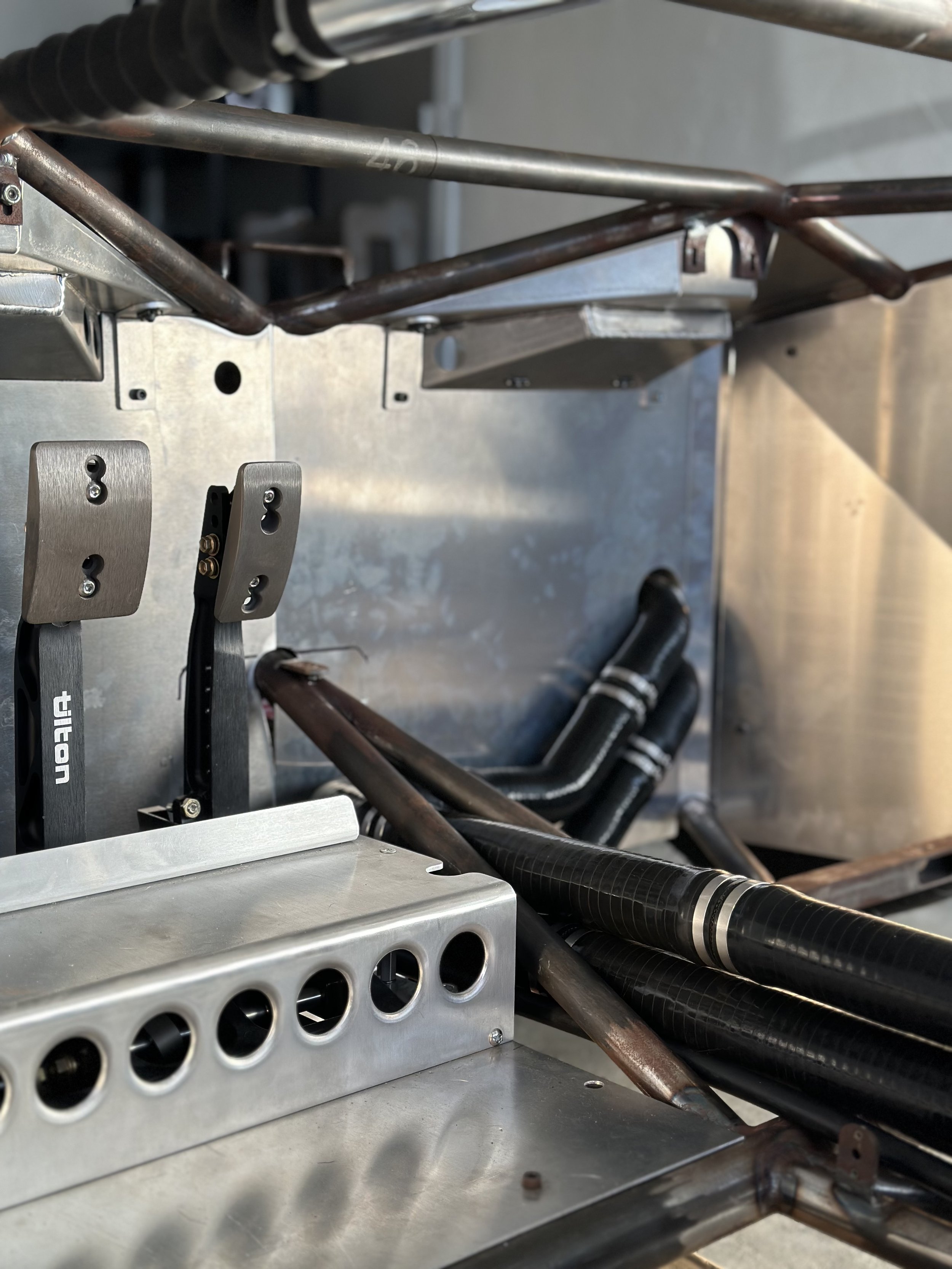Edition #TWELVE
Laguna is Alive
(This newsletter was previously sent out to our email subscribers. To receive updates the moment they happen, consider subscribing via our home page.)
In last month’s newsletter I mentioned that Kyle and I were on the home stretch of assembling Laguna Prototype 1, and we would spend the next few weeks buried in wiring and plumbing for Laguna’s electrical, cooling, and fuel systems so we could fire up the engine for the first time. What do you know… that’s exactly what happened!
We began November with the first item of the to-do list: install the shifter linkage that connects Laguna’s six-speed sequential transmission to the billet aluminum gearshift lever. In doing so, we discovered that a brass bushing in the linkage was causing the shifter to bind. Replacing it with a specially coated plastic bushing resulted in a significantly smoother gear change. It joins the carbon fiber seats and a few 3d-printed engine components as one of the only plastic pieces on the entire car. Check it out on our new YouTube account - subscribers welcome!
Next up: install the remainder of Laguna’s cooling system, pressure test, and add coolant. Twenty-two feet of silicone hose circulates three gallons of coolant from the engine to the expansion tank, and then to the custom radiator before heading back to the engine. Once the hoses were connected and in their final location, they were sealed together with 42 hose clamps. If you’ve never tightened 42 hose clamps in a row, don’t worry, you’re not missing out. The production car will use formed aluminum hard lines, which means less weight and less joints. The photo below shows where the hoses pass through the middle of the car. The aluminum lines will follow the same routing as the prototype lines, fully enclosed by the floorpan and center tunnel for protection.
The last part of the cooling system to install was the race-grade thermostat. The thermostat is a critical part of the cooling system: it brings the engine up to operating temperature quickly by rerouting the coolant in a tiny loop through just the engine, instead of going to the radiator, causing the coolant to heat up quickly. Once it reaches 178˚ F, a valve opens and the coolant is redirected to the radiator. If you’ve ever been told to “bring your car up to temperature” before stomping on the gas, this is what that means. A quick pressure test confirmed the entire system was sealed, so we filled it up!
After finishing the cooling system, I filled the engine with five liters of oil and we ran the fuel line, which took less than five minutes. It’s pretty easy to work on a car when there isn’t any bodywork to get in the way. A quick test confirmed the fuel pump was working perfectly, and after running some fuel through the rubber line to remove any debris, we connected it to the engine. Hoping the inline-6 would be ready to start, we powered up the electrical system but noticed the electronic throttle was unresponsive. The engine would crank, idle for a fraction of a second and then die because the throttle wasn’t opening. Thankfully, Kyle was able to solve the issue after several days of [frankly ingenious] troubleshooting, and with the throttle now functioning we were ready to try again. What happened next was incredible… You have to give this a listen!
There is still much development work to do on the engine, but this was a huge milestone for us considering how smoothly it already runs. We will use bespoke engine management and our own wiring harness for production, but our prototype engine runs on the BMW electronics that powered it in the donor motorcycle. It’s an ultra-modern CAN bus system with ten modules, dozens of sensors, and hundreds of wires (check out the bike’s wiring diagram below). We were able to trick the computers into thinking the engine is stock even though it’s breathing through a new intake system with roughly 3x more airflow and totally different plumbing. Additionally, the electronic actuator that had previously operated a single throttle body in the motorcycle is now responsible for six of them! While all of these changes still need to be accounted for with an ECU remap, Laguna’s beating heart already revs like it can’t wait to get out on the road (or track) and stretch its legs past 10,000 rpm.
We are now just a few tasks away from our first drive. We have a little more wiring work (connecting the motorcycle’s twist grip throttle sensor to a new pedal-mounted sensor, and then hiding as many wires as we can in a sealed electronics box), running brake and clutch lines, and some final component installs (like the half-shafts) to do. After that, we can finally begin driving the car that we have spent the last two and a half years engineering from the ground up. In the meantime, you can visit our website to learn more about our vision for Shoreline Bespoke, reach out, and shop for apparel. By subscribing to this newsletter, you’ll be the first to know about vehicle updates, future reveals, apparel releases and more… stay tuned.
Sincerely,
Spencer Beckman
Founder & CEO, Shoreline Bespoke Vehicles



